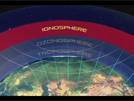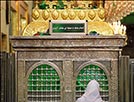JA’FAR AS-SADIQ (a.s.) IN HIS FATHER’S ACADEMY
- Details
- Hits: 975
When Ja’far as-Sadiq (a.s.) joined the college, his father had just started teaching Geography of Ptolemy. The day he attended his class, he heard, for the first time, the name of Almagest, the book on geography and astronomy written by Ptolemy, who lived in the second century A.D. He also heard for the first time from his father that the earth was round.
Some people believe that it is because of Copernicus of Poland (1473-1543 A.D), that we know that the earth is a sphere. As a matter of fact all the learned people of ancient Egypt knew that the earth is a sphere.
There is a book in the library of the Vatican, which was written one thousand years before Copernicus was born. In this book it is clearly mentioned that the earth is a sphere.
Before Copernicus had expounded his theory that the earth and planets rotate around the sun, Christopher Columbus had started his westward journey towards the island of spices knowing that the earth is round.
Before the theory of Copernicus was published Magellan of Portugal, who was in the service of the King of Spain, had sailed from Seville, a port of Spain, and went round the world. He himself was killed by the people of the Philippines but his companions returned to Spain after three years. This was the first time that it was definitely established that the earth is a sphere.
Ptolemy wrote in Almagest that the earth is the centre of the universe and that the sun and planets go round it. But Copernicus stated that the sun is the centre of the solar system and the earth and other planets rotate around it.
In the year 91 A.H. two important events took place. The first was that a student of Muhammad al-Baqir (a.s.) while returning from Egypt, brought, as a present for him, a representation of the solar system which was made from sawdust. In Egypt, statues and many other fine objects were made from sawdust which was first turned into a kind of dough. Visitors to Egypt took them home as souvenirs. Outside of Egypt they were considered valuable items and were in great demand.
The representation of the solar system brought by Muhammad bin Fatah from Egypt consisted of a round disc or stand which represented the earth. On the disc was a globe, 48 clusters of stars or constellations, which were known to Ptolemy. The names of the constellations were written in Egyptian language. It was not Ptolemy but astronomers from other nations, who saw the figures of different objects in these haphazard groups of stars and gave them the names of these objects.
In the middle of the globe was belt of 12 groups of stars, from Aries to Pisces, representing the signs of the Zodiac. The sun, moon and the planets, which were believed to rotate round the earth, were also clearly shown on this globe.
Ja’far as-Sadiq (a.s.) was only 11 years of age when this representation of the heavenly bodies was brought to Medina from Egypt. The day he saw the globe he rejected the theory of Ptolemy. He said that when the sun, during its course round the earth, passes through the 12 constellations in one year and remains in each constellation for 30 days why does it disappear from sight during the night. It should remain visible in each constellation for 30 days.
This was a very strong objection by a boy of 11 years of age. But without understanding the logic of it, Muhammad bin Fatah, who had brought the present from Egypt, replied, “Ptolemy says that the sun has two movements. One of its movements is that it crosses the sign of the zodiac and goes round the earth in one year and the other movement is that it goes round the earth in one night and one day, as a result of which we see it rise in the east and set in the west.
Ja’far al-Sadiq (a.s.) remarked that those two movements were not compatible. When the sun had to pass through the sign of the zodiac in one year and stay in each constellation for 30 days how could it change its course and go round the earth in 24 hours?
Muhammad bin Fatah said, “The sun leaves the belt of 12 constellations at night and rises in the east and sets in the west in order to create day and night.”
Ja’far as-Sadiq (a.s.) retorted, “It follows from what you say that only in the daytime the sun is in the sign of the zodiac. If this is the case why do we not see the sun at night?” Muhammad bin Fatah replied, “I do not know why we do not see the sun at night. Most probably it casts a thick veil one its face.”
Some people might say that it is not a strange thing that the people of Medina did not pay attention to what Ja’far as-Sadiq (a.s.) had said when in the 17th Century A.D. the people of England did not pay any attention to Newton’s discovery. But there is a vast difference between the two. The common people of England in the 17th century A.D. were illiterate and to them a scientific discovery was of no significance, but the people, who attended the classes of Muhammad al-Baqir (a.s.) were learned people. They should not have behaved the way they did. They should have discussed the problem with Ja’far as-Sadiq (a.s.), accepted his arguments or rejected them by means of logic and reason, then tried to find out the case of the interchange of day and night themselves. The level of their intelligence and understanding was so low that they did not understand his objection and the strength of his arguments. They treated him like a child and ignored his objections.
It is a fact that after the age of seven, children become very inquisitive and want to know everything. Sometime they ask so many questions that their parents get irritated. If they do not receive satisfactory replies they go on asking questions. It can be said that because of his age, the objections of Ja’far as-Sadiq (a.s.) were not taken seriously. Anyway, it is doubtful that they would have been taken seriously even if a grown-up person raised them.
In the middle of the 15th century A.D. Copernicus had said the same thing that Ja’far as-Sadiq (a.s.) had said in the 8th century A.D., but no one accepted his views. He was fortunate that Poland, where he lived, was not under the jurisdiction of the Court of Inquisition when he published his theory of rotation of the earth and planets round the sun. This was the same organization which had forced Galileo to repent and beg for mercy for having said that the earth rotated round the sun. If he had been in Germany, France, Spain or Italy, he would have been arrested. At that time the Grand Inquisitor was a very cruel and narrow-minded person by the name of Torquemada. He extracted their confession by force and then punished them.
Imam Reza (AS) Network











